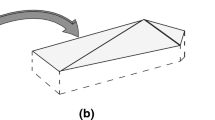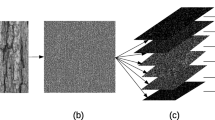Abstract
Image texture provides a rich visual description of the surfaces in the scene. Many texture signatures based on various statistical descriptions and various local measurements have been developed. Existing signatures, in general, are not invariant to 3D geometric transformations, which is a serious limitation for many applications. In this paper we introduce a new texture signature, called the multifractal spectrum (MFS). The MFS is invariant under the bi-Lipschitz map, which includes view-point changes and non-rigid deformations of the texture surface, as well as local affine illumination changes. It provides an efficient framework combining global spatial invariance and local robust measurements. Intuitively, the MFS could be viewed as a “better histogram” with greater robustness to various environmental changes and the advantage of capturing some geometrical distribution information encoded in the texture. Experiments demonstrate that the MFS codes the essential structure of textures with very low dimension, and thus represents an useful tool for texture classification.
Similar content being viewed by others
References
Aloimonos, J. (1988). Shape from texture. Biological Cybernetics, 58, 345–360.
Azencott, R., Ping, J., & Younes, L. (1997). Texture classification using windowed Fourier filters. IEEE Transactions on Pattern Analysis and Machine Intelligence, 19(2), 148–153.
Bajcsy, R., & Lieberman, L. (1976). Texture gradient as a depth cue. Computer Graphics and Image Processing, 5(1), 52–67.
Chantler, M., Petrou, M., Penirsche, A., Schmid, M., & McGunnigle, G. (2005). Classifying surface texture while simultaneously estimating illumination direction. International Journal of Computer Vision, 62(1–2), 83–96. Special Issue on Texture Analysis and Synthesis.
Chaudhuri, B. B., & Sarkar, N. (1995). Texture segmentation using fractal dimension. IEEE Transactions Pattern Analysis and Machine Intelligence, 17(1), 72–77.
Chen, Y.-W., & Lin, C.-J. (2006). Combining SVMs with various feature selection strategies. In Feature extraction, foundations and applications. Berlin: Springer.
Conci, A., & Monteiro, L. H. (2000). Multifractal characterization of texture-based segmentation. In ICIP (pp. 792–795) 2000.
Cula, O. G., & Dana, K. G. (2001). Compact representation of bidirectional texture function. In CVPR (Vol. I, pp. 1041–1047) 2001.
Dana, K., & Nayar, S. (1998). Histogram model for 3d textures. In CVPR (pp. 618–624) 1998.
Efros, A., & Leung, T. (1999). Texture synthesis by non-parametric sampling. In ICCV (pp. 1039–1046) 1999.
Espinal, F., Jawerth, B. D., & Kubota, T. (1998). Wavelet-based fractal signature analysis for automatic target recognition. Optical Engineering, 37(1), 166–174.
Falconer, K. J. (1997). Techniques in fractal geometry. New York: Wiley.
Forsyth, D. A., & Ponce, J. (2002). Computer vision: a modern approach. Englewood Cliffs: Prentice Hall.
Garding, J., & Lindeberg, T. (1996). Direct computation of shape cues using scale-adapted spatial derivative operators. International Journal of Computer Vision, 17(2), 163–191.
Johnson, A., & Hebert, M. (1999). Using spin images for efficient object recognition in cluttered 3d scenes. IEEE Transactions Pattern Analysis and Machine Intelligence, 21(5), 433–449.
Julesz, B. (1965). Texture and visual perception. Science America, 212, 38–48.
Kam, L., & Blanc-Talon, J. (2000). Are multifractal multipermuted multinomial measures good enough for unsupervised image segmentation. In CVPR (pp. 58–63) 2000.
Kaplan, L. M. (1999). Extended fractal analysis for texture classification and segmentation. IEEE Transactions on Image Processing, 8(11), 1572–1585.
Kaplan, L. M., & Kuo, C. C. J. (1995). Texture roughness analysis and synthesis via extended self similar (ESS) model. IEEE Transactions Pattern Analysis and Machine Intelligence, 17(11), 1043–1056.
Kervrann, C., & Heitz, F. (1995). A Markov random field model-based approach to unsupervised texture segmentation using local and global spatial statistics. IEEE Transactions on Image Processing, 4(6), 856–862.
Konishi, S. M., & Yuille, A. L. (2000). Statistical cues for domain specific image segmentation with performance analysis. In CVPR (pp. 1125–1132) 2000.
Laine, A., & Fan, J. (1993). Texture classification by wavelet packet signatures. IEEE Transactions on Pattern Analysis and Machine Intelligence, 15(11), 1186–1191.
Lazebnik, S., Schmid, C., & Ponce, J. (2005). A sparse texture representation using affine-invariant regions. IEEE Transactions on Pattern Analysis and Machine Intelligence, 8(27), 1265–1278.
Leung, T., & Malik, J. (2001). Representing and recognizing the visual appearance of materials using three-dimensional textons. International Journal of Computer Vision, 43(1), 29–44.
Liu, F., & Picard, R. W. (1996). Periodicity, directionality, and randomness: World features for image modeling and retrieval. IEEE Transactions on Pattern Analysis and Machine Intelligence, 18(7), 722–733.
Liu, X., Yu, Y., & Shum, H. (2001). Synthesizing bidirectional texture functions for real-world surfaces. In Proc. ACM SIGGRAPH (pp. 117–126) 2001.
Lowe, D. (2004). Distinctive image features from scale-invariant keypoint. International Journal of Computer Vision, 60(2), 91–110.
Malik, J., & Rosenholtz, R. (1997). Computing local surface orientation and shape from texture for curved surfaces. International Journal of Computer Vision, 23(2), 149–168.
Mallat, S. G. (1989). A theory for multi-resolution signal decomposition: the wavelet representation. IEEE Tran. on Pattern Analysis and Machine Intelligence, 11, 674–693.
Mandelbrot, B. B. (1982). The fractal geometry of nature. Freeman: San Francisco.
Matas, J., Chum, O., Urban, M., & Pajdla, T. (2002). Robust wide baseline stereo from maximally stable extremal regions. In Proc. BMVC, 2002.
Mihran, T. (1994). Moment based texture segmentation. Pattern Recognition Letters, 15, 659–668.
Mindru, F., Tuytelaars, T., Van Gool, L., & Moons, T. (2004). Moment invariants for recognition under changing viewpoint and illumination. Computer Vision and Image Understanding, 94(1), 3–27.
Mundy, J. L., & Zisserman, A. (1992). Geometric invariance in computer vision. Cambridge: MIT Press.
Neubeck, A., Zalesny, A., & Van Gool, L. (2004). Viewpoint consistent texture synthesis. In 3D Data processing, visualization and transmission (3DPVT) 2004.
Peleg, S., Naor, J., Hartley, R., & Avnir, D. (1984). Multiple resolution texture analysis and classification. IEEE Transactions on Pattern Analysis and Machine Intelligence, 6, 518–523.
Portilla, J., & Simoncelli, E. P. (2000). A parametric texture model based on joint statistics of complex wavelet coefficients. International Journal of Computer Vision, 40(1), 49–71.
Schmid, C. (2001). Constructing models for content-based image retrieval. In CVPR (Vol. 2, pp. 39–45) 2001.
Teuner, A., Pichler, O., & Hosticka, B. J. (1995). Unsupervised texture segmentation of images using tuned matched Gabor filters. IEEE Transactions on Image Processing, 4(6), 863–870.
UIUC dataset. (2006). http://www-cvr.ai.uiuc.edu/ponce_grp/data/index.html.
UMD dataset. (2006). http://www.cfar.umd.edu/users/fer/website-texture/texture.htm.
Varma, M., & Garg, R. (2007). Locally invariant fractal features for statistical texture classification. Proc. IEEE international conference on computer vision, 2007.
Varma, M., & Zisserman, A. (2002). Classifying images of materials: Achieving viewpoint and illumination independence. In ECCV (Vol. 3, pp. 255–271) 2002.
Varma, M., & Zisserman, A. (2003). Texture classification: are filter banks necessary? In CVPR (Vol. 2, pp. 691–698) 2003.
Vehel, J. L., Mignot, P., & Berroir, J. P. (1992). Multifractals, texture, and image analysis. In CVPR (pp. 661–664) 1992.
Weiss, I. (1993). Geometric invariants and object recognition. International Journal of Computer Vision, 10(3), 207–231.
Wendt, H., Abry, P., & Jaffard, S. (2007). Bootstrap for empirical multifractal analysis. In IEEE signal processing magazine (pp. 38–48) 2007.
Xia, Y., Feng, D., & Zhao, R. (2006). Morphology-based multifractal estimation for texture segmentation. IEEE Transaction on Image Processing, 15(3), 614–623.
Xu, Y., Ji, H., & Fermüller, C. (2006). A projective invariant for textures. In CVPR (Vol. 2, pp. 1932–1939) 2006.
Zalesny, A., & Van Gool, L. (2001). Multiview texture models. In CVPR (Vol. 1) 2001.
Zhu, S. C., Wu, Y., & Mumford, D. (1998). Filters, random-fields and maximum entropy (FRAME): Towards a unified theory for texture modeling. International Journal of Computer Vision, 27(2), 107–126.
Author information
Authors and Affiliations
Corresponding author
Additional information
This research was supported in part by the National Science Foundation, under a grant on NETS-NOSS: Sensory grammars for sensor networks, and a grant on Biologically Inspired Computing: SEER: A gigascale neuromorphic vision system, by the European Commission under the 7th Framework Program on Cognitive Systems (project POETICON), and by the National Nature Science Foundation of China (No. 60603022), National 973 Program of China (No. 2009CB320505). Part of the work was conducted while Yong Xu was visiting the Computer Vision Lab at UMD supported by the China Scholarship Council (No. [2003]3006).
Rights and permissions
About this article
Cite this article
Xu, Y., Ji, H. & Fermüller, C. Viewpoint Invariant Texture Description Using Fractal Analysis. Int J Comput Vis 83, 85–100 (2009). https://doi.org/10.1007/s11263-009-0220-6
Received:
Accepted:
Published:
Issue Date:
DOI: https://doi.org/10.1007/s11263-009-0220-6




